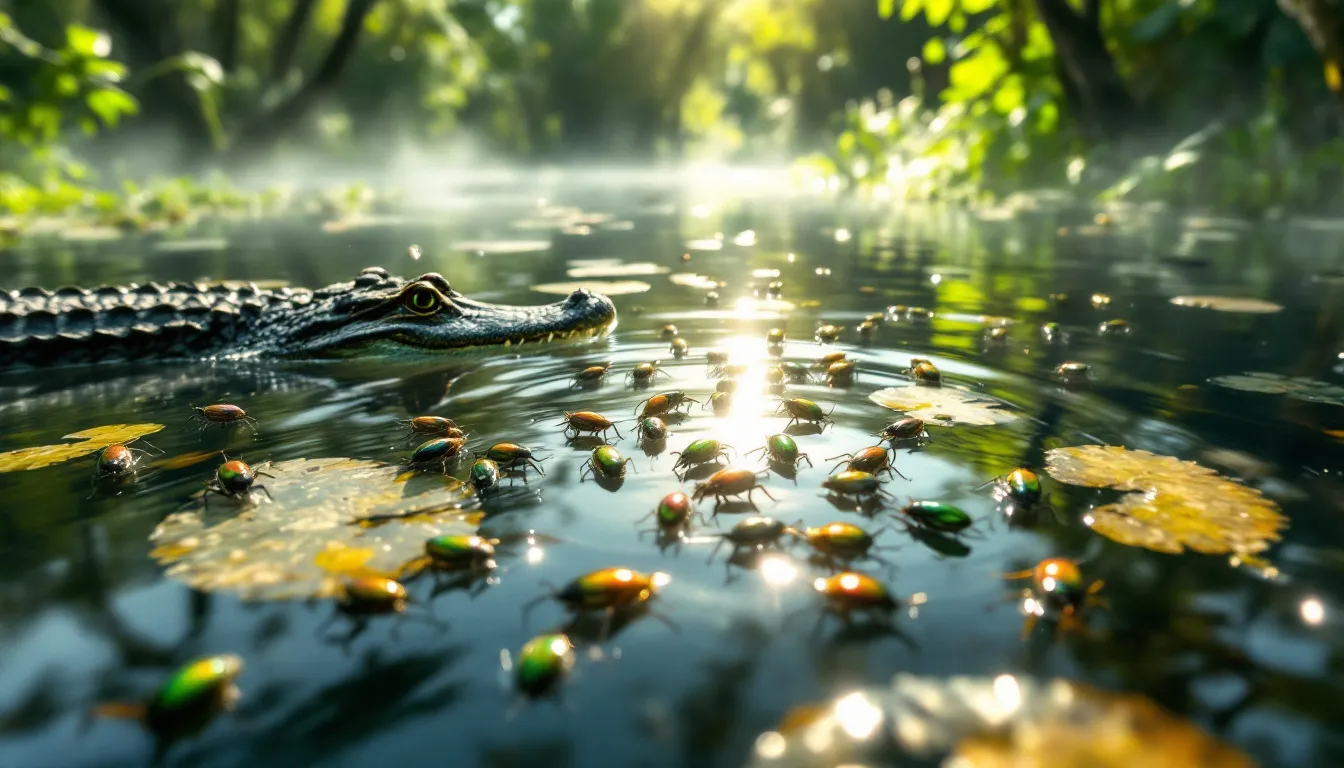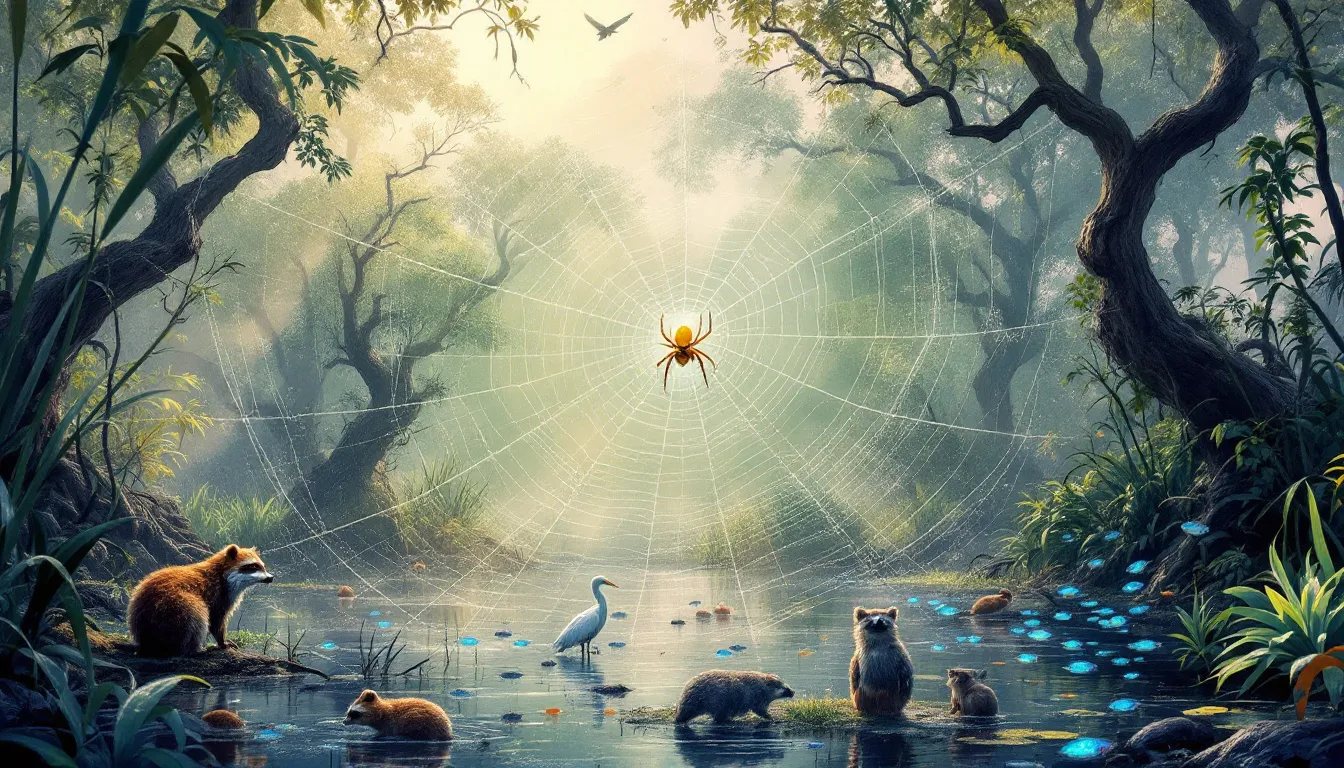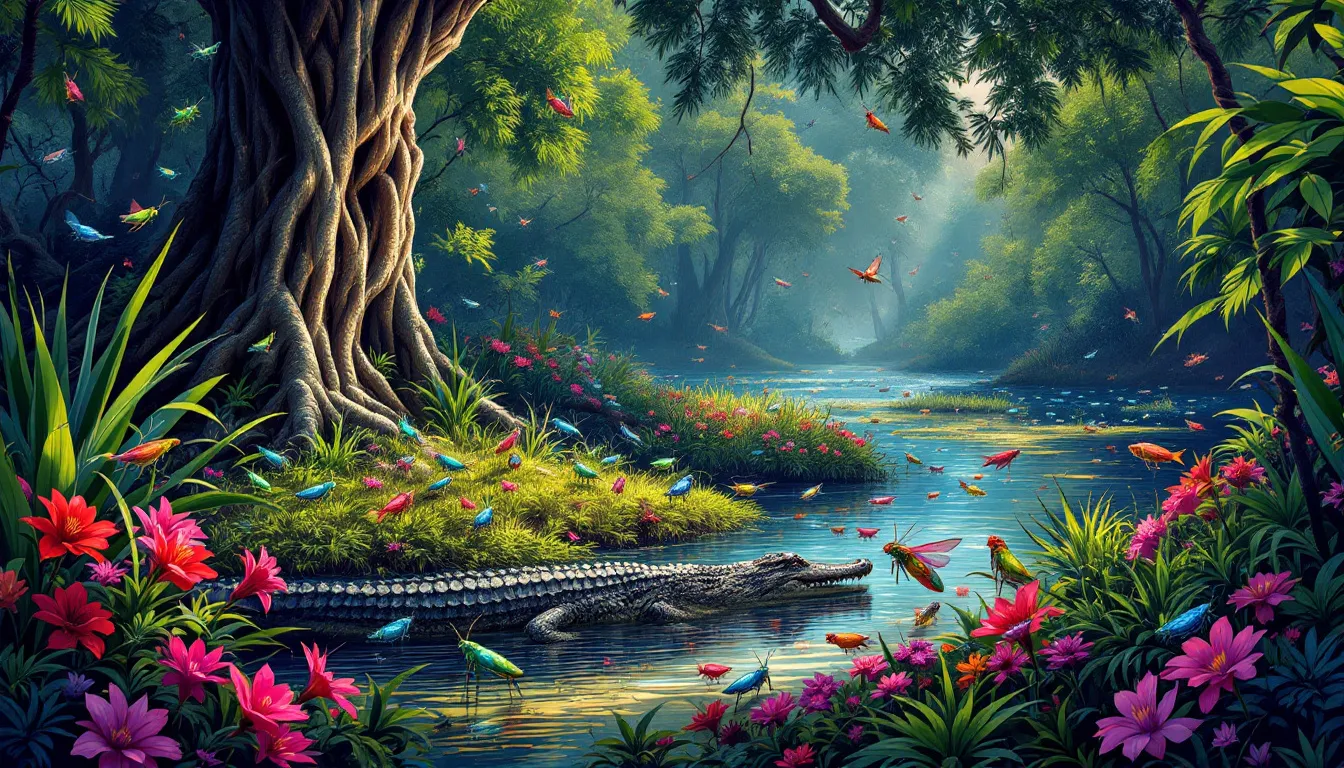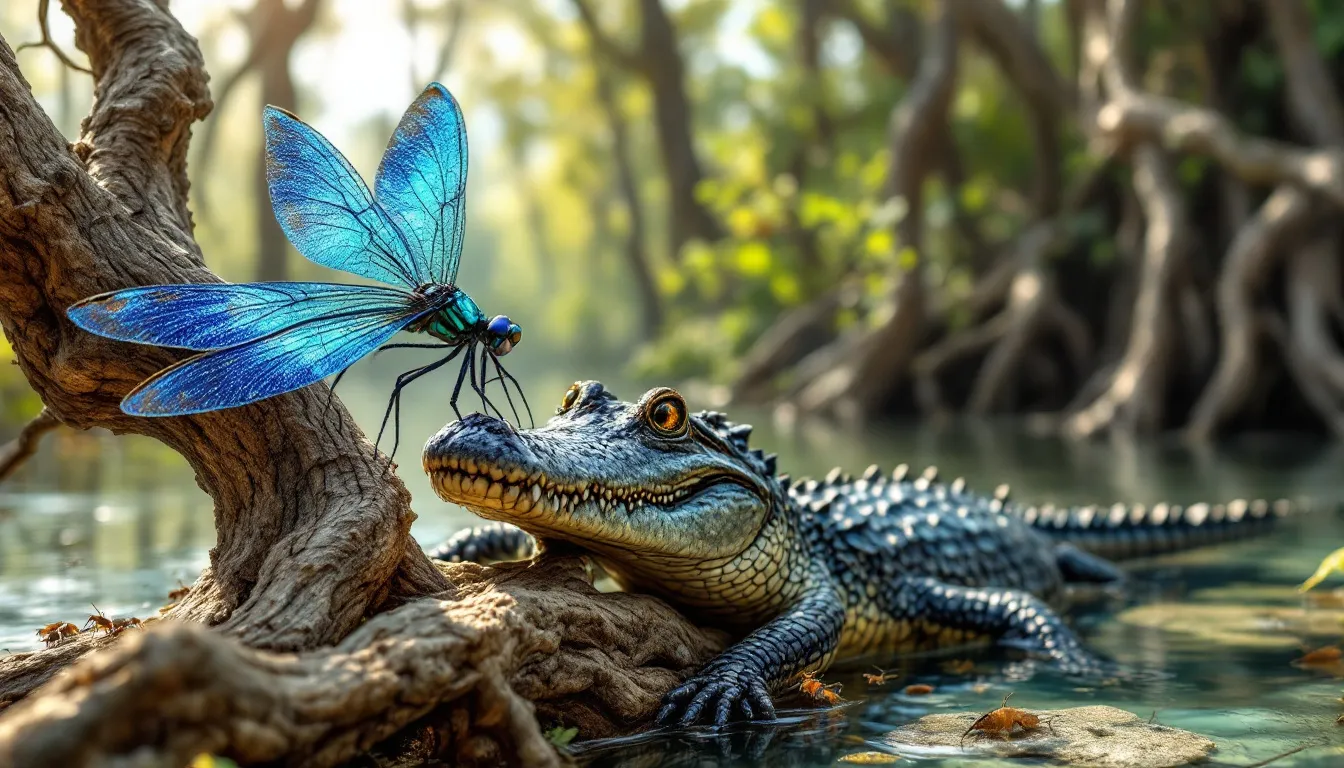Are there bugs in the Everglades? Yes, and they are everywhere. This wetland is home to thousands of insect species that are vital to its complex ecosystem. In this article, we’ll explore the different types of bugs you might encounter in the Everglades and their roles in maintaining ecological balance.
Key Takeaways
- The Everglades hosts over 20,000 insect species, from giant whip scorpions to colorful lubber grasshoppers, all vital for the ecosystem’s balance.
- Invasive species like the island apple snail and Lobate Lac Scale pose serious threats to native plants and animals, disrupting the local food chain.
- Airboat tours, guided by local experts, provide an exciting way to explore and learn about the diverse insect life in the Everglades.
Are There Bugs in the Everglades? Exploring Insects & More
Absolutely, the Everglades is teeming with insects! The region’s humid and warm climate supports a myriad of insect species. This biodiversity includes both native and invasive species, all contributing to the intricate web of life in the Everglades ecosystem. But that’s not all; there are Nile crocodiles in Florida, including the Everglades, and these live amongst hundreds of species of birds, insects, flora, and fauna in this rich and intricate marsh environment.
Giant whip scorpions, also known as tailless whip scorpions, hide in burrows and beneath rotting wood. These nocturnal predators prey on soft-bodied insects, helping to maintain ecological balance. The diversity extends from dragonflies skimming the water’s surface to beetles burrowing in the swampy soil, showcasing the Everglades’ vibrant insect life.
Airboat tours offer an immersive experience for those eager to explore this insect haven firsthand. Guided by local experts, these tours provide a unique chance to observe Everglades insects in their natural habitat, making it an adventure not to be missed.
Introduction
The Everglades support a vast array of life forms, including over 20,000 insect species. Many species, like the endemic Florida leafwing butterfly, highlight this incredible diversity. From pollinators like bees and butterflies to predators like dragonflies and spiders, insects play a crucial role in maintaining the ecological balance and food web of this wetland paradise, which is home to a million insect species.
The wetland habitat, with its grass, islands, and forests, creates unique conditions to which many insects have adapted. These adaptations influence their behavior and life cycles, making the Everglades a fascinating place for studying insect life.
Whether you’re fascinated by the intricate dances of dragonflies or the vital pollination work done by bees, the Florida Everglades offer a rich tapestry of insect life to explore.
Whirligig Beetles in the Swampy Ecosystem

Whirligig beetles are intriguing residents of the Everglades’ swampy ecosystem. Known for their rapid, circular swimming patterns on the water’s surface, these small beetles play a significant role by feeding on mosquito larvae and other fallen insects.
The Everglades’ ecosystem faces challenges, including invasive species like the island apple snail, which consumes a wide range of aquatic vegetation. This can have a cascading effect on native species and the overall health of the swampy ecosystem.
Observing these dynamics can be captivating during airboat tours, where local guides provide insights into the lives of these incredible insects and other animals, including the phenomenon of an air bubble underneath.
Golden Orb Spiders: The Everglades’ Golden Silk Weavers

Golden orb spiders, also known as banana spiders, are among the most fascinating arachnids in the Everglades. Their silk, which appears gold in sunlight, is both beautiful and extremely strong. These spiders weave intricate webs with their golden silk, playing a vital role in controlling insect populations.
Their colorful appearance acts as a warning signal to potential predators about their toxicity. Observing these golden silk orb weavers in the wild is a highlight for many visitors, adding another layer of wonder to the diverse Everglades ecosystem.
Lubber Grasshoppers: Colorful but Toxic

The Eastern lubber grasshopper stands out among Everglades insects due to its large size and vibrant colors. Native to Florida and the Southeastern Coastal Plain, these grasshoppers are hard to miss. Their colorful appearance serves as a warning to potential predators of their toxic nature.
Despite their toxicity, lubber grasshoppers serve as prey for certain birds and other predators that have adapted to their toxins. Their striking appearance and interesting behaviors make them a fascinating subject for those exploring the Everglades.
Lobate Lac Scale: An Invasive Threat
Lobate Lac Scale is an invasive insect posing a significant threat to the Everglades’ plant life. First observed infesting trees in Florida in 1999, these insects can cause severe damage, leading to the death of affected trees and shrubs. They primarily target species like wax myrtle and coco plum, infesting over 90 tree species in Florida.
The impact of the Lobate Lac Scale on the Everglades is profound, emphasizing the importance of managing invasive species to preserve the natural balance and health of this unique environment.
Island Apple Snail and its Impact on the Food Chain
The island apple snail is another invasive species with significant implications for the Everglades’ food chain. Much larger than the native Florida apple snail, it can grow to the size of a tennis ball. This size difference allows it to outcompete native species, leading to a decline in the food supply for snail kites, which rely on the Florida apple snail for sustenance.
The introduction of the island apple snail disrupts the delicate balance of the food chain, highlighting the complex interactions between species in the Everglades.
Evil Weevil and Bromeliad Trees
The Evil Weevil, also known as the Lobate Lac Scale, is a notorious pest that has caused significant damage since its introduction to Broward County in 1999. Originating from India and Sri Lanka, this invasive species primarily targets trees like wax myrtle, coco plum, and strangler fig, posing a serious threat to the health of the Everglades.
For bromeliad enthusiasts, the damage caused by the Evil Weevil is particularly concerning as it threatens the survival of these unique plants. Managing the spread and impact of this invasive insect is crucial for preserving the biodiversity of the Everglades.
Mosquito Larvae: A Common Sight
Mosquito larvae are ubiquitous in the swampy waters of the Everglades. These larvae are a vital part of the ecosystem, serving as a crucial food source for various aquatic animals, including fish and other insects. Their presence also indicates healthy wetland environments, as they are sensitive to pollution and habitat changes.
Despite their potential for growing into mosquitoes that deliver painful bites, mosquito larvae play an essential role in the food chain and environmental health of the Everglades. Observing these tiny life forms can offer valuable insights into the overall health of the ecosystem.
Other Notable Insects in the Everglades

The Everglades is home to a staggering number of insect species, each contributing to the ecosystem’s richness and complexity. Dragonflies, for instance, are not only beautiful to watch but also serve as important predators of mosquitoes and other insects. Beetles, like the bromeliad beetle, also play a crucial role in maintaining the ecosystem’s health.
Insects in the Everglades are essential for pollinating plants and providing food for other wildlife, ensuring the continuity of the food web. The diversity of mosquitoes, while sometimes a nuisance, also highlights the adaptability and resilience of these insects. Each species, whether a pollinator or a predator, plays a part in maintaining the balance of this unique ecosystem.
Experience Everglades Insects with Airboat Tours Fort Lauderdale
For those eager to see Everglades insects up close, airboat tours in Fort Lauderdale offer an unforgettable experience. Led by professional guides, these tours provide an opportunity to explore the rich biodiversity of the Everglades in a way that’s both educational and thrilling. The tours are private, ensuring a personalized experience tailored to your specific interests in Everglades wildlife.
Booking an airboat tour is simple and can be done through their website or by calling (561) 563-4165. Whether you’re a seasoned entomologist or a curious nature lover, these tours offer a unique window into the world of Everglades insects.
Summary
The Everglades is a vibrant ecosystem teeming with insect life. From the dazzling golden silk of the orb spiders to the toxic allure of lubber grasshoppers, each species plays a vital role in maintaining the delicate balance of this unique environment. Invasive species like the Lobate Lac Scale and island apple snail present challenges, but they also highlight the dynamic and ever-changing nature of the Everglades.
Exploring the Everglades through airboat tours provides a deeper appreciation of its incredible biodiversity and the intricate relationships between species. As we continue to learn about and protect this ecosystem, we ensure that future generations can enjoy and study the myriad life forms that call the Everglades home.
Frequently Asked Questions
What makes the Everglades an ideal habitat for insects?
The Everglades’ warm and humid climate is perfect for a wide variety of insects, making it their ideal playground. It’s no wonder so many species thrive there!
How do mosquito larvae contribute to the Everglades ecosystem?
Mosquito larvae play an important role in the Everglades ecosystem by providing food for a range of aquatic animals and signaling the health of wetland environments. They’re more than just pests; they’re part of the natural food web!
What is the impact of the island apple snail on the Everglades food chain?
The island apple snail messes up the Everglades food chain by pushing out native Florida apple snails, which means less food for the snail kites that depend on them. It’s a big deal for the balance of the ecosystem!
What are some notable insects in the Everglades?
The Everglades boasts over 20,000 insect species, with dragonflies, beetles, and those pesky mosquitoes being the most notable. They’re all key players in keeping the ecosystem balanced!
How can I experience the insects of the Everglades up close?
To experience the insects of the Everglades up close, hop on an airboat tour in Fort Lauderdale with an experienced guide who can show you the amazing biodiversity. It’s a fun way to get right into the action!
